Every year Barcelona are linked with a plethora of superstars, those already well established and also those in making, and in recent times, the La Liga giants were not afraid to pull the trigger and seal mega-deals along the way.
But their search for a Luis Suárez replacement in the form of a young and hungry no.9 has taken them far too long.
For that reason, the deal to bring Lautaro Martinez of Inter to the Camp Nou seems more than just a feasible solution.
But would the young Argentine ‘Toro’ be a good solution for Barcelona?
Would Lautaro Martinez fit Barcelona’s tactics?
This tactical analysis scout report will aim to deliver a verdict on exactly that.
The Lautaro Martínez analysis will delve into Barcelona’s style of play and see whether the 22-year-old would be a good investment this summer.
Who Is Lautaro Martínez?
Lautaro Martínez is currently one of the hottest players out there in the market.
The 22-year-old centre-forward has the potential to become among the best modern strikers on the planet and has exploded onto the scene in recent years.
He can boast with an incredible physique, power, and pace to outmuscle defenders, win duels and attack the space with intent.
But his intelligent movement and positioning make him stand out from the rest – the Argentine can both recognise and exploit the space and is also able to create it for his teammates.
Martínez regularly drops deeper in order to link up with his midfield, progress the ball and advance it into the final third.
And while he is also versatile enough to drift wide and act as a second-striker in a duo up front, he is also extremely deadly inside the box with a brilliant eye for goal.
It doesn’t really surprise that he is subject of interest from multiple European giants but Barcelona seem like the favourites in the race for his signature.
But how exactly does he fit their tactics? This tactical analysis scout report will now turn to some of his best traits and see whether the Blaugranas could use them in their squad.
The Barcelona no.9
It is essential we first identify the centre-forward that would suit Barcelona’s tactics and their overall system.
Facing low and deep blocks is usually a nightmare for most teams and the Catalans have to do it in almost every single game they play.
For that reason, their centre-forward has to be fluid in his movement, able to drop and drift to take defenders out of their shape and bring his teammates into play and also has to attack the space with intent.
If we take Suárez as the perfect example, we can see that the Uruguayan will often have a healthy dialogue with the midfield, dragging defenders out of their line, swapping places with other players and most importantly – use his movement and runs to create space for his teammates, primarily Lionel Messi.
While Barcelona originally thought Antoine Griezmann might be the one to take over Suárez in the long run, the Frenchman ended up being more of a Messi than a Suárez, forcing the Catalans into the market once more.
But this time, they can’t get it wrong.
But by comparing Martínez’s heatmap to the one of Suárez and Griezmann, we can see some subtle differences between them.
Note, however, that we’re using Griezmann’s heatmap from his last Atlético Madrid season as he’s been mostly used as a left-winger at Barcelona.

Movement and positioning will be crucial for the new Barcelona no.9 and we can see that Lautaro still spends most of his time inside the box and in the zone 14, similarly to Suárez’s preferred area of operation.
Griezmann, on the other hand, is a completely different profile that likes to sit deeper and operate through the half-spaces, either left or right, depending on the movement of his wingers and the other striker.
This is a big plus for the young Argentine because this means there won’t be many overlaps on the pitch and instead of stepping on each other’s toes, Barcelona’s forward line should finally start complementing each other.
We can also compare their player profiles through a statistical analysis, looking at both the defensive and the attacking spectre.
Note, however, that the graph below will use Suárez’s 2018/19 campaign as he’s missed the majority of the ongoing season both through injury and because of the recent outbreak that put football on hold.
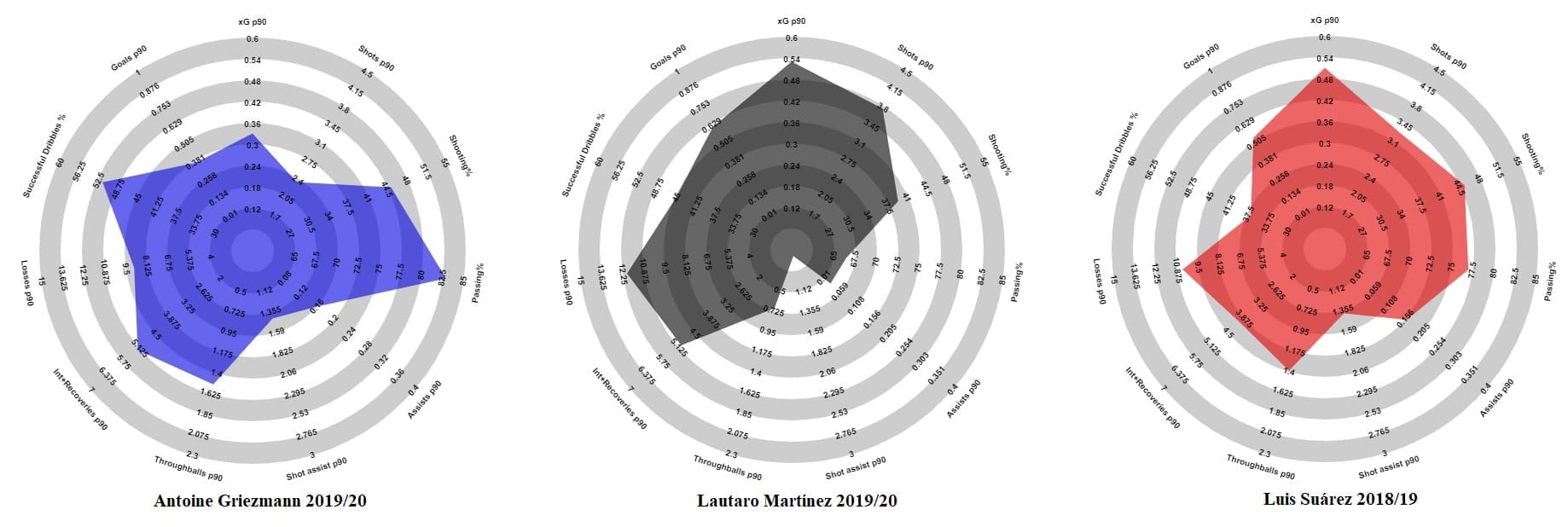
While we can see Martínez is a big presence in the final third, contributing with a high average of goals, xG, dribbles and shots – which is more akin to the Uruguayan than the Frenchman – he is also not as secure in possession nor is he that big of a creator, especially compared to Griezmann.
Another thing to note is Suárez’s decline in recent years and this comparison doesn’t really do him justice because prime Suárez was a much more complete striker than the version we saw in 2018/19.
But while it’s essential Martínez is similar to Suárez, it’s also crucial that he enables Messi and doesn’t limit the area in which his compatriot operates.
While Inter don’t play with a clear no.10 as the playmaker per se, Martínez is often the one to drift wide to accommodate to the other forward’s, in this case Romelu Lukaku’s, movement.
We can already see that tendency in his heatmap above and also in the example below.
As Antonio Candreva cuts into the box from the wide area, Martínez recognises the run and decides to drift onto the flank and receive the ball on the right as opposed to staying central.
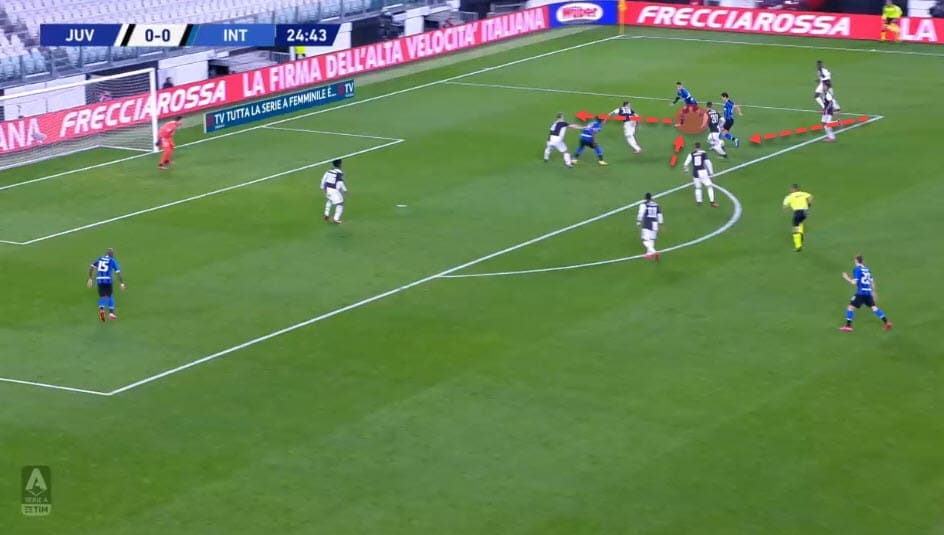
While this may sound like a basic movement from a modern striker, the Argentine is brilliant when it comes to identifying where and how to exploit free pockets of space in regards to his teammates’ movement.
We can already imagine Messi’s central penetration being followed up by Toro’s drifts towards the wide areas.
That course of action can result in a) Martínez dragging away markers and clearing the path for Messi or b) Forcing defenders to collapse on Messi, leaving the youngster unmarked for a potential through ball from his teammate.
It’s something Suárez does regularly and something Barcelona have missed sorely with his absence.
So we concluded that he occupies the right areas and is willing and able to alter his positioning to complement his teammates when necessary, as visible from the example and his heatmap.
But another clear aspect of a Barcelona no.9 is his dialogue with the midfield.
We can constantly see Suárez in deeper areas, providing that additional outlet, laying off the ball or just dragging the markers out of their shape.
Luckily for the Catalans, Martínez is more than capable of doing the exact same thing.
Notice below a fairly standard example where the Argentine has dropped deeper to receive the ball, hold it off against a defender before laying it off into space for his teammate.
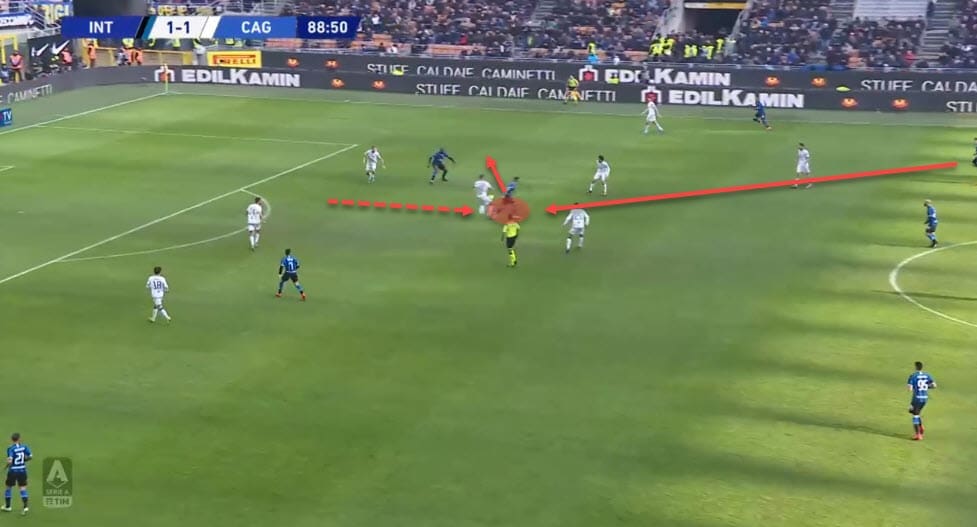
This is also a crucial aspect for unlocking deep blocks, as we’ve already mentioned in this tactical analysis Lautaro Martinez scout report, since it serves the purpose of reshuffling the opposition’s defensive line and helps progress the ball.
But that could also be a potential stumbling block for the young Argentine and Barcelona’s tactics as a whole.
In his first season at Inter, Martínez had a big issue when facing deep blocks because he wouldn’t have the necessary space to run into and if his wingers dropped deeper, just like for example Messi and Griezmann do, he would often end up isolated inside the box.
If, on the other hand, there were no willing runners into the box and he decided to drop deeper towards his midfield himself, Barcelona could potentially suffer the same problem as they are facing now – there would be no one to penetrate the opposition’s defensive line and they would have too many players occupying the wrong zones on the pitch.
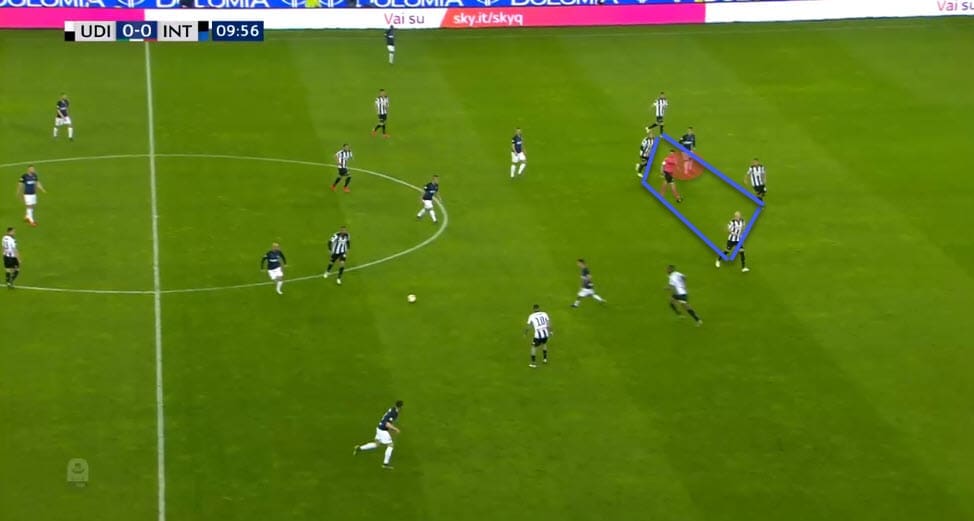
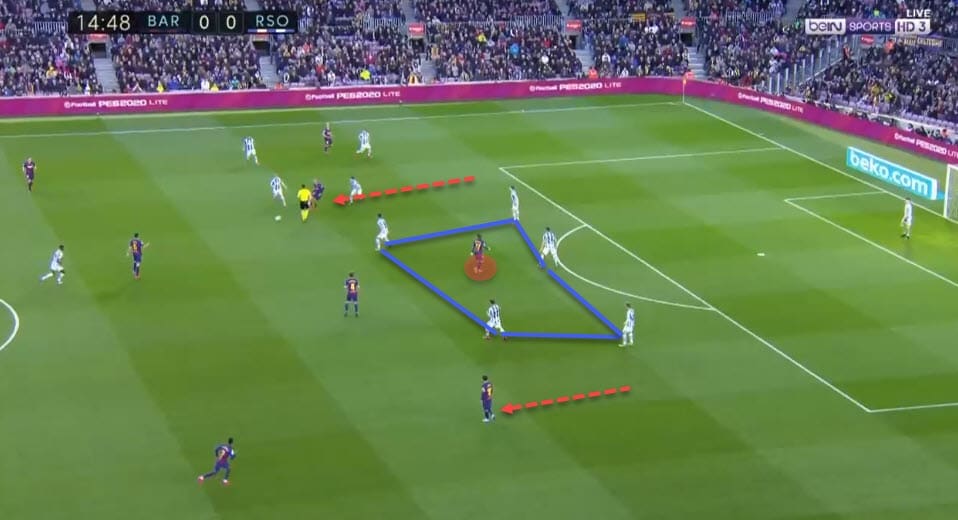
Above, we can see the examples that illustrate Martínez isolated in the final third and Barcelona in a rather similar scenario with no natural wingers and Griezmann on his own approaching the box.
Antonio Conte fixed that issue upon his arrival by implementing a system with two strikers and Lukaku’s transfer suited their tactics perfectly.
The Diamond
So now we know Martínez has the necessary tools to become Barcelona’s no.9 despite lacking in certain areas but how do they fit all three of Suárez, Griezmann and the potential new arrival into the team? Let’s entertain the idea that Martínez would indeed bench the Uruguayan and be a regular part of the first-team squad.
And while in theory, that would mean Messi on the right, Martínez down the middle and Griezmann on the left, we’ve seen that that kind of setup doesn’t suit the Frenchman and he’s being heavily underutilised in Catalonia so far.
Keeping him on the left doesn’t seem like an optimal solution at all.
But looking at both players in question, it is possible to have them both on the pitch at the same time, have them in a familiar position and still not limit Messi in his free-roam role across the final third.
For this to work, however, Barcelona would have to deploy a 4-4-2 diamond system.
Let’s see how that could potentially work below.

We already know Martínez works extremely well in a striker partnership – we’ve seen as much at Inter where he plays side by side with Lukaku.
In that duo, however, the Argentine is usually the second-striker as that was his main role in the 2019/20 campaign.
Since he does like to drop deeper to link up with the midfield and progress the ball from those areas, that role suits him quite well.
But he also has all the characteristics to be the centre-forward whose task would be to stay higher, only drifting wide when necessary, and move inside the box to create and exploit space.
When we take a look at his shot distribution and where most of his opportunities come from, we can see that he’s still far more dangerous the closer he gets to the goal.
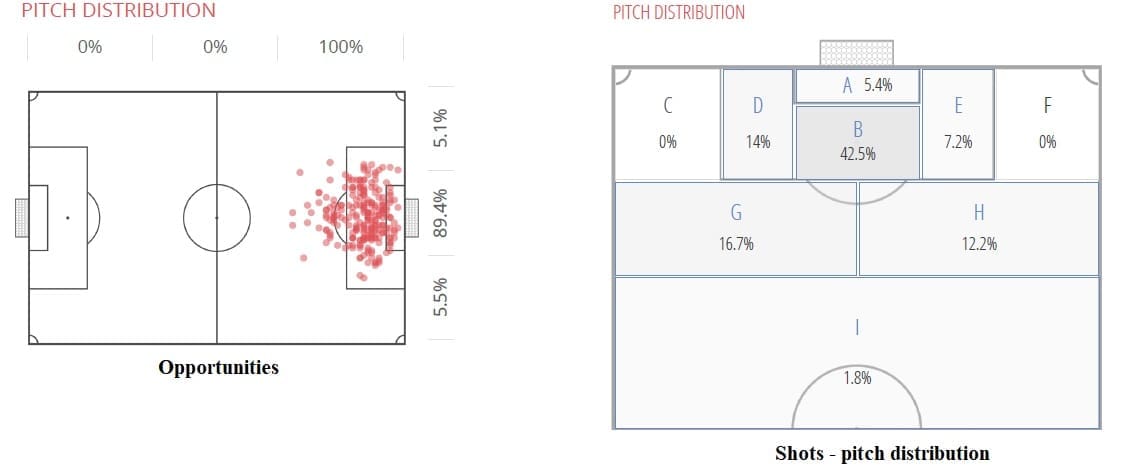
For that reason, deploying him as the centre-forward would not hinder his potential too much and would most likely increase his xG output as he would have to transition more into a role of the poacher than a creator/ finisher hybrid.
Moreover, his brilliant positional awareness and the ability to attack and exploit space are traits best used inside the box rather than in deeper areas of the pitch.
But most importantly, it would mean Griezmann would be able to play as Barcelona’s second-striker with more freedom and in a far more familiar role.
Back at Atlético Madrid, the Frenchman was the main cog in attack for Diego Simeone’s men and he operated just behind Diego Costa in a duo up front.
But Griezmann would often be the deeper-positioned of the two, helping progress the ball through half-spaces and be a creative spark, as we’ve seen from the initial heatmap at the beginning of this tactical analysis scout report.
We can see how Griezmann’s profile was slightly altered upon arrival to Barcelona and the Frenchman seems a bit more constricted in his approach than he was at his last season in Madrid.
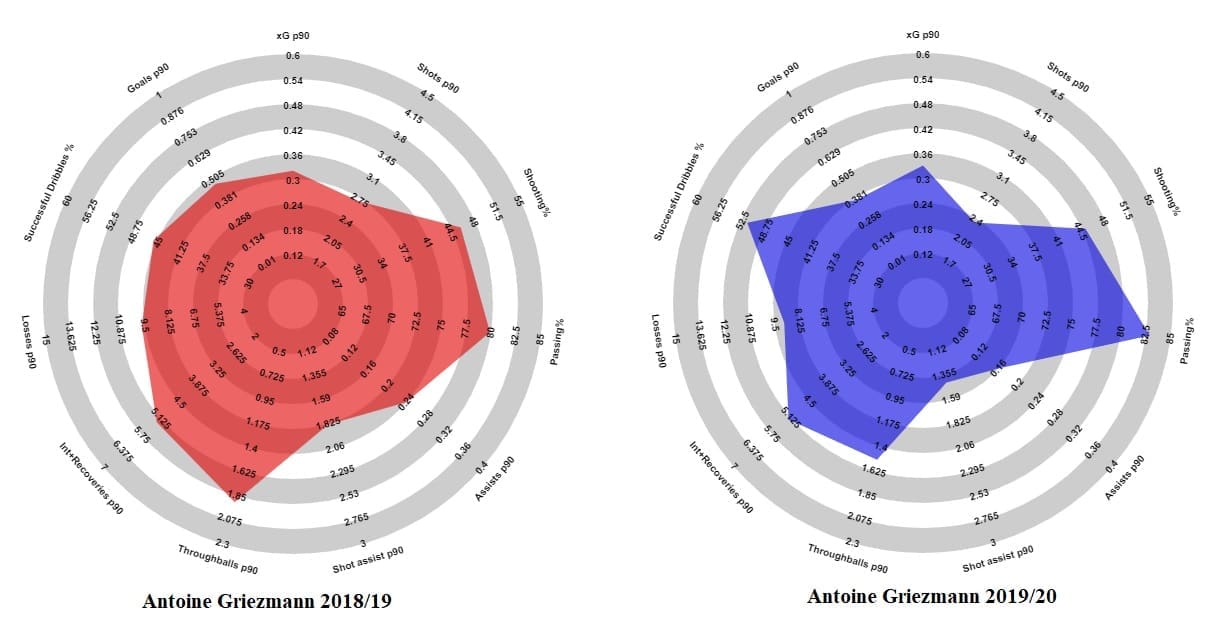
In that scenario with Griezmann and Lautaro up front, Messi would operate at the tip of the diamond as an attacking midfielder, just in front of a deeper-positioned midfield trident of Sergio Busquets, Frenkie de Jong and Arthur Melo.
With all three of them preferring to operate in deeper areas, and with the creative duties shared by Griezmann and Messi through the central areas combined with Martínez’s space exploitation and constant movement, Barcelona would, on paper, finally have the right formula.
And since there are currently no natural wingers at the club bar Ousmane Dembélé, they would essentially abandon the role for now and the width would have to be exclusively provided by the full-backs.
This, again, could pose a problem since they have been lacking in that area as of late as well.
But that’s an analysis for another time.
There’s also quite an underrated tactical aspect this formation could bring as well and it concerns Barcelona’s efficacy in defending and defensive transitions.
Martínez is a very willing runner and always contributes to the pressing at Inter.
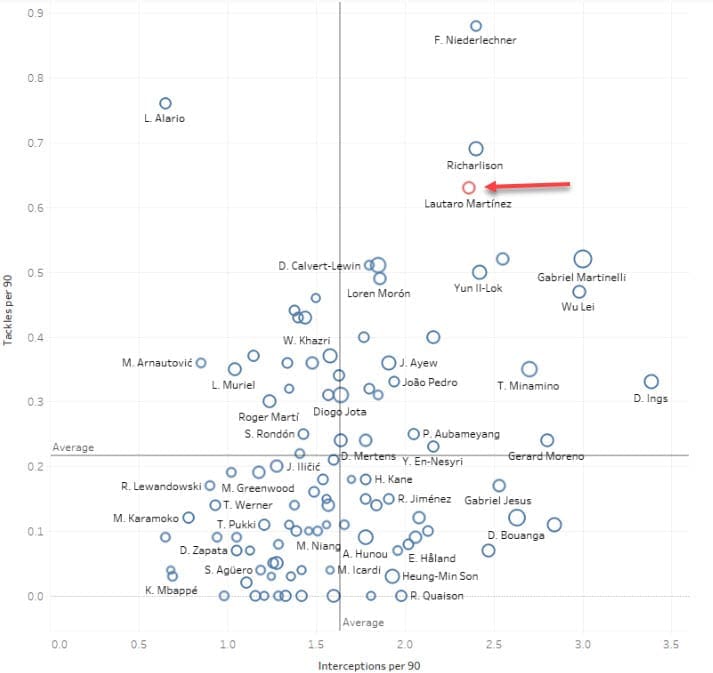
You can see his defensive contribution per 90 minutes in 2019/20 in the graph above that outlines how attackers fare in that department.
Martínez is rated quite highly and can boast with 2.4 interceptions per 90 minutes as well as winning 33.8% of all of his loose ball duels.
Seeing how Messi is usually quiet in the defensive phase, Barcelona would have Martínez and Griezmann to deploy their high press, along with the aid of the midfield, without losing too much intensity due to the Argentine’s absence.
Upon further inspection of Martínez’s defensive actions, we can see that the majority of his duels, interceptions and 1v1 defending indeed happens in the opposition’s half, further highlighting his contribution to the press.
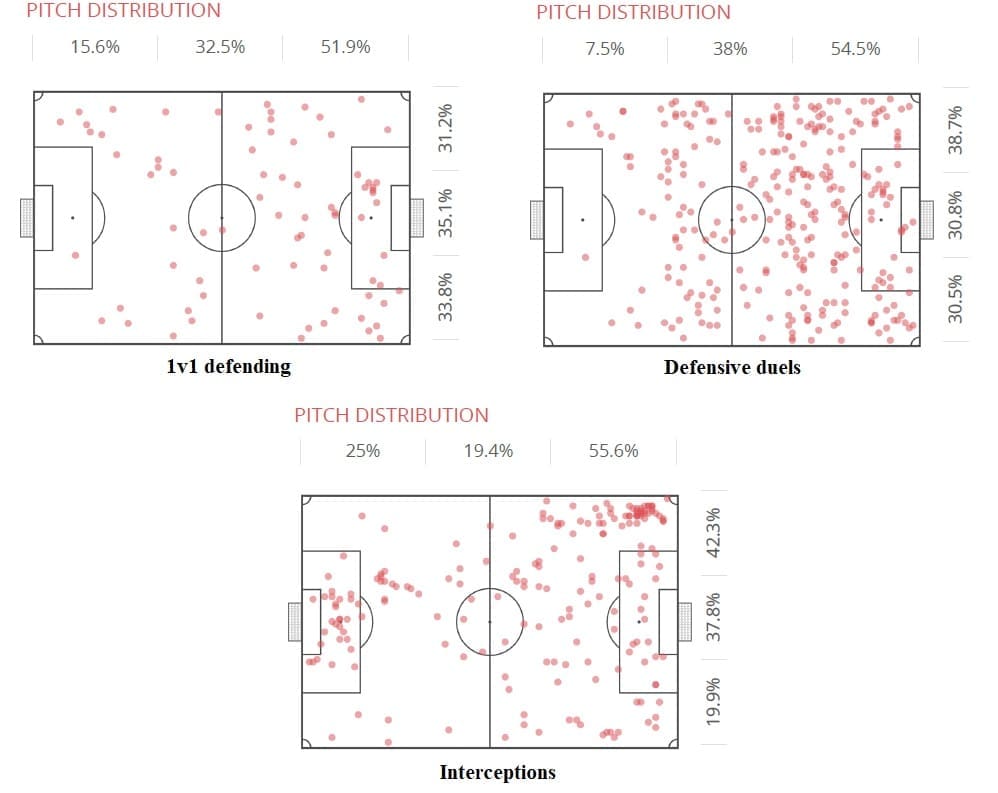
Not to mention that he would bring a certain dose of threat in transitions as he’s quite adept at carrying the ball with power and pace, often starting from deeper areas for a deadly counter.
In 2019/20, he mustered 1.21 progressive runs per 90 minutes.
This is also aided by his great dribbling abilities with 4.97 per 90 minutes with a 44.8% success rate, which helps him escape challenges from the opposition defenders.
Existing blueprint
Luckily, we’ve already seen Messi and Martínez interact on the pitch when playing for their national team.
And interestingly enough, Argentina were also deployed in a rather similar system to the one we’ve suggested in the section above.
And Lautaro has been used both as a sole striker in a 4-3-3 formation with Messi on the right-wing and in a striker partnership in a 4-3-1-2 system where Messi was the attacking midfielder.
Of course, in both cases, Barcelona’s talisman drifts inside and occupies the same zones but his teammates have different tasks.
You can see Martínez’s heatmaps from both of those games below.
We can note two distinct things.
Firstly, he stays higher up the pitch and mostly moves inside the box and secondly, he can drift wide – either inside or outside the area – when necessary to complement his teammate’s movement.

The example against Venezuela is perfect for us because in that game, Martínez was used as the centre-forward while Sergio Agüero was the second-striker and Messi the no.10.
That is the exact same scenario as our Barcelona one from the previous section of this tactical analysis scout report but here, we have Agüero instead of Griezmann.
The principle, however, remains the same.
Martínez is the one to stay higher up the pitch, pin the centre-backs and look to exploit the space.
Agüero – who’s the stand-in for Griezmann – has a bit more freedom in a deeper role and can occasionally drop deeper or drift wider according to Messi’s movement and Messi has a free reign to be the deep playmaker as well as make progressive runs into the final third.
We can see that setup in the image below.
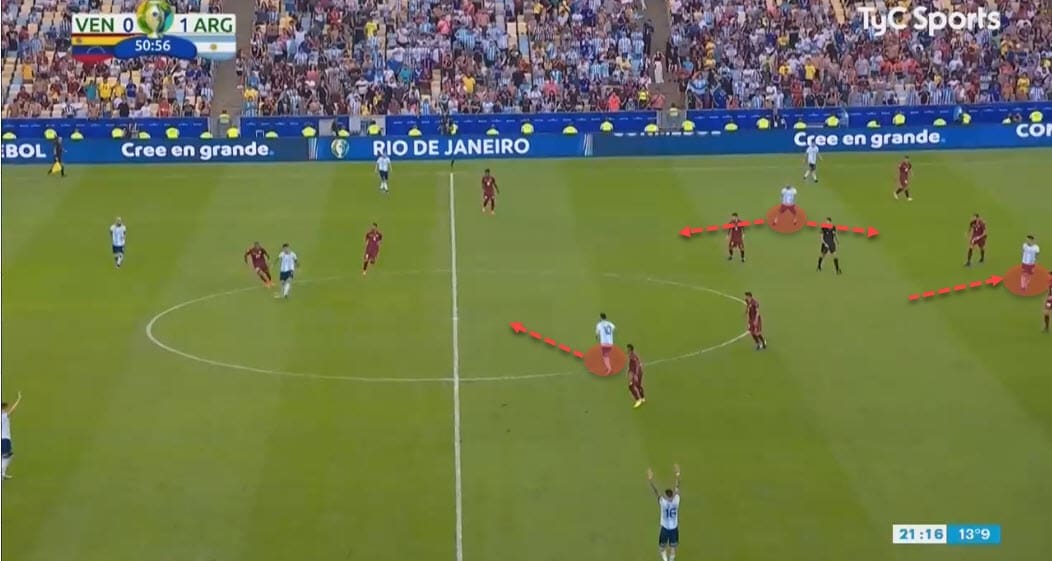
In this setup, we would also expect Argentina to get their width through the full-backs who would be positioned higher and when they’d attack through the centre, each of the forwards would have a unique set of duties.
Notice how Messi starts dropping deeper during the build-up phase, carrying a marker with him, Agüero drifts wide while occupying a defender on the flank and Lautaro charges forward and into the space with pace.
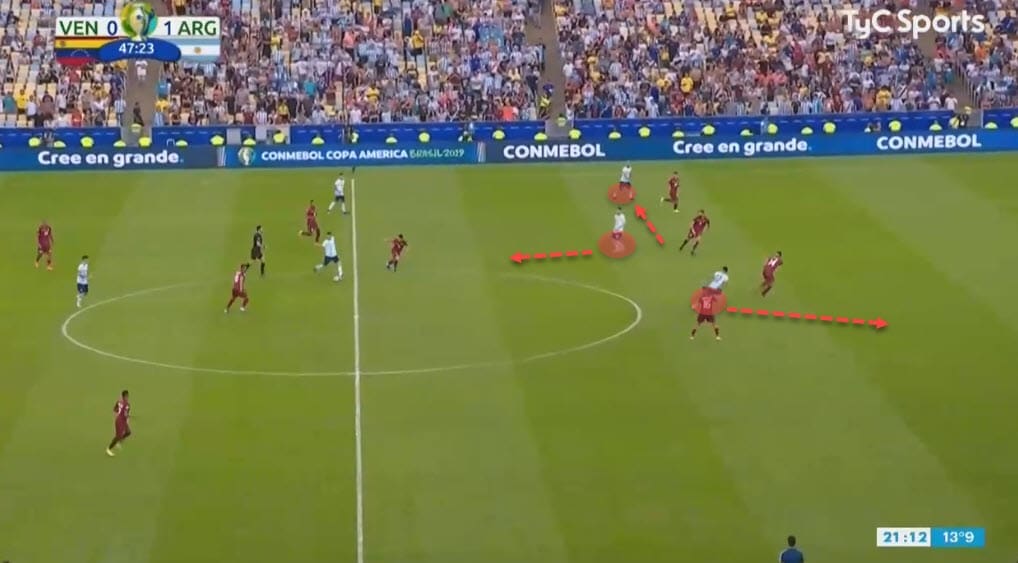
This could, in theory, work just as well, if not better, at Barcelona.
Especially considering the personnel there is of much higher quality and that should make this system a better option for the Catalans than the traditional 4-3-3 with no natural wingers.
Of course, we’ve seen that Martínez has the necessary weapons in his arsenal to play that role well too but this might be a better way to go.
There is also an additional caveat and that’s the possibility of pairing up Suárez and Lautaro instead of doing it with Griezmann.
That would potentially be something similar to Inter’s setup and the Argentine’s partnership with Lukaku.
But in that case, Griezmann would be either relegated to the bench or sold altogether.
Let’s see what Barcelona end up deciding.
Final remarks
It does seem like Martínez is quite suitable for Barcelona and the potential issues can be ironed out as he improves and adapts over time.
The biggest problem, however, could be of financial nature but the state of the market is still very much under a question mark in regards to the recent outbreak.
Getting him in would indeed be a shrewd piece of business for the Blaugranas, if they can somehow manage it financially, that is.
At the moment, they need a player who’s more like Suárez and less like Messi or Griezmann but yet able to do more than just score goals.
As always, they have special criteria for their ideal centre-forward.
Martínez might not tick all the boxes but he comes pretty close to it overall.
Let’s see whether they manage to seal the deal in the end.






Comments